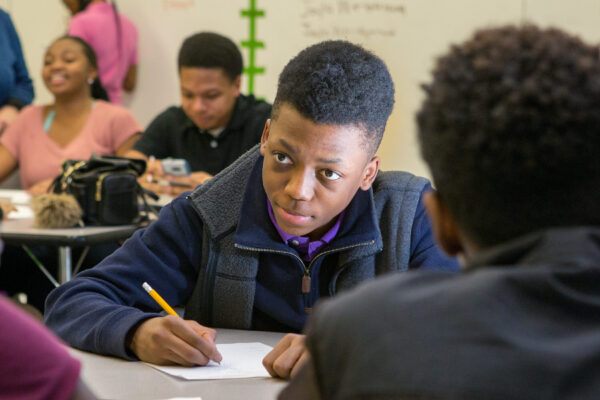This piece originally appeared in The Hechinger Report.
Thousands of public school districts and charter schools have turned to tutoring as a popular and effective way to jumpstart lagging student performance post-pandemic.
Educators strongly endorse tutoring, when done right, and believe it can help students make real academic gains. In an effort to spur the tutoring movement, the Biden administration recently called on colleges and universities to devote at least 15 percent of their federal work-study funds to pay eligible college students to tutor.
This could be a win-win. Tapping into the $1.2 billion work-study program — launched in 1964 to make part-time employment part of college students’ financial aid awards — would boost K-12 student academic performance while providing undergraduates with valuable work experience.
Building a work-study path to tutoring would also ease the cost of college.
It is going to take more than federal encouragement to make work-study a viable funding source, however. There are significant bureaucratic and political barriers to tapping work-study’s potential to boost tutoring.
One obstacle stems from the way federal work-study funds flow. They go to colleges and universities rather than directly to college students, requiring potential work-study providers to win approval from every institution they work with. Even in a system like the University of California, providers must work separately with UCLA, UC Berkeley, UC San Diego and the rest.
In addition, the federal government allows higher education institutions to decide what share of tutoring wages they will cover. While some pay their students’ full wages, others may cover as little as 75 percent, leaving tutoring providers to find funds to pay the rest.
The result is a daunting bureaucratic and budgetary landscape for tutoring organizations, says Sam Olivieri, chief executive of California-based nonprofit Step Up Tutoring, one of the few tutoring providers using federal work-study funding.
Olivieri estimates that less than 10 percent of the nation’s college students could provide intensive tutoring to 25 percent of all public elementary school students.
Federal work-study rules and regulations have become a barrier to bringing potentially thousands of college students into public school classrooms as tutors, says Katie Hooten, founder and director of Teach For America’s nonprofit Ignite tutoring fellowship, which recruits students from their college campuses to provide high-dosage tutoring virtually.
Hooten notes that if the 10-campus University of California system adopted one standard approach, it would enable Ignite and other tutoring providers to hire tutors from the system’s 280,000 students far faster. They would not have to negotiate and manage separate partnerships with each college.
Two federal policy moves could ease the logjams these barriers create: a national, standardized system for vetting and approving tutoring partners and incentives for universities to pay the same percentage of work-study funds toward their students’ tutoring wages.
If national tutoring organizations meet quality standards, the federal government could approve them to work as federal work-study partners with every college and university. That approval could come with a commitment by institutions to pay tutoring positions at a standard rate.
There’s yet another obstacle to this solution, though. Republicans in the U.S. House of Representatives want to end the federal work-study program and shift its budget to Pell Grants, which go directly to students without involving college or university administrators.
To overcome this obstacle, Congress could instead consider a pilot program that gives work-study funds to students who participate in tutoring programs like Step Up, Ignite and other nationally approved programs. They could provide students with lump-sum payments akin to Pell Grants.
Once college students completed their tutoring obligations, they would receive work-study funds directly from the federal government without institutional involvement.
In the case of Ignite tutors, for example, they would receive a $1,200 stipend after completing an Ignite tutoring block (30 minutes of virtual tutoring in small groups four days a week for 10 weeks).
The strong research supporting Ignite and other “high-impact” tutoring programs has generated an uncommon level of bipartisan support for extending the reach of tutoring — which has a history of serving as a mostly privately purchased aid for students who can afford to pay.
Case in point: The number of private tutoring centers in the U.S. more than tripled between 1997 and 2016, from roughly 3,000 to almost 10,000.
A work-study investment targeted at tutoring would contribute to the Biden administration’s goal of increasing both the number of tutors and the number of K-12 students getting tutored.
Members of Congress who unsuccessfully sought to pass the College Affordability Act in 2019 and are still eager to address rising college costs would also likely support a substantial work-study investment in tutoring.
And paying college students directly after they complete their tutoring commitments would address Republicans’ concerns about funding flowing through universities.
A work-study path to tutoring could help ease the cost of college while tapping a vast source of support for the nation’s schools.
That would be both a political winner and a potential game-changer for the education sector.

